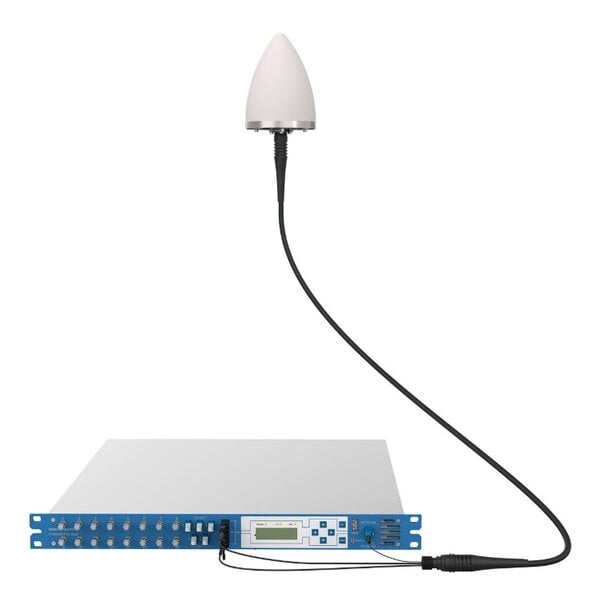www.industryemea.com
20
'25
Written on Modified on
HUBER+SUHNER simplifies optical timing for precision data centers
HUBER+SUHNER's SYNCRO family offers integrated, modular timing and GNSS distribution, simplifying optical timing for data centers, cutting costs, and achieving nanosecond accuracy over fiber.
www.hubersuhner.com

The SYNCRO family is an integrated, modular timing and Global Navigation Satellite System (GNSS) distribution portfolio designed for rapid deployment and reliable performance by extending transmission distances, reducing the number of required GNSS antennas, and eliminating many limitations of coaxial cabling.
GNSS provides the reference time used across modern networks and critical infrastructure. GNSS signals originate from satellites carrying atomic clocks, with the extreme stability of those clocks acting as the basis for international timekeeping and enabling sub nanosecond synchronisation when distributed correctly.
Building on previous GNSS and Power-over-Fiber (PoF) offerings, SYNCRO delivers secure, precise timing synchronisation over fiber, while preserving nanosecond accuracy across an operator’s network. PoF is a key advantage of the SYNCRO approach as optical fiber carries both the GNSS timing signal and required energy to remote antenna assemblies, allowing rooftop or remote antennas to be powered without separate electrical wiring. Crucially, SYNCRO integrates seamlessly into an operator’s existing fiber network, reusing optical infrastructure to deliver both signal and safe, centrally managed power to remote GNSS antenna locations.

“The increasing computing requirements as a result of advancing digitalisation, particularly in cloud computing, artificial intelligence (AI) and location-independent working, mean that data center operators must constantly upgrade or create new capacities,” says Dominik Tibolla, Product Manager at HUBER+SUHNER. “Operators are looking for solutions that scale the performance of modern data centers in a future-proof manner, upgrade existing infrastructures with minimal effort and ensure maximum security, reliability and comprehensive monitoring, including antenna redundancy. SYNCRO has been developed to support operators in these efforts.”
By expanding our current offering, SYNCRO is available in three customisable product sets so customers can select the right balance of power, monitoring, and redundancy for their operations. The SYNCRO Max provides full PoF capability and signal expansion, monitoring, and redundancy for the most demanding deployments. SYNCRO Eco delivers the signal expansion and monitoring features of the Max without PoF for customers that do not require remote powering. Simpler applications that do not require PoF or redundancy can utilise the SYNCRO Mini, which still maintains monitoring and signal expansion capabilities.
By moving timing distribution onto fiber, SYNCRO eliminates many installation constraints and reduces planning overhead. The plug-and-play design removes the transmission distance limits of coaxial cabling, reduces the need for reinforced ducting and extensive grounding to protect against lightning surges, and allows longer secure transmission between antennas and receivers.
www.hubersuhner.com
GNSS provides the reference time used across modern networks and critical infrastructure. GNSS signals originate from satellites carrying atomic clocks, with the extreme stability of those clocks acting as the basis for international timekeeping and enabling sub nanosecond synchronisation when distributed correctly.
Building on previous GNSS and Power-over-Fiber (PoF) offerings, SYNCRO delivers secure, precise timing synchronisation over fiber, while preserving nanosecond accuracy across an operator’s network. PoF is a key advantage of the SYNCRO approach as optical fiber carries both the GNSS timing signal and required energy to remote antenna assemblies, allowing rooftop or remote antennas to be powered without separate electrical wiring. Crucially, SYNCRO integrates seamlessly into an operator’s existing fiber network, reusing optical infrastructure to deliver both signal and safe, centrally managed power to remote GNSS antenna locations.

“The increasing computing requirements as a result of advancing digitalisation, particularly in cloud computing, artificial intelligence (AI) and location-independent working, mean that data center operators must constantly upgrade or create new capacities,” says Dominik Tibolla, Product Manager at HUBER+SUHNER. “Operators are looking for solutions that scale the performance of modern data centers in a future-proof manner, upgrade existing infrastructures with minimal effort and ensure maximum security, reliability and comprehensive monitoring, including antenna redundancy. SYNCRO has been developed to support operators in these efforts.”
By expanding our current offering, SYNCRO is available in three customisable product sets so customers can select the right balance of power, monitoring, and redundancy for their operations. The SYNCRO Max provides full PoF capability and signal expansion, monitoring, and redundancy for the most demanding deployments. SYNCRO Eco delivers the signal expansion and monitoring features of the Max without PoF for customers that do not require remote powering. Simpler applications that do not require PoF or redundancy can utilise the SYNCRO Mini, which still maintains monitoring and signal expansion capabilities.
By moving timing distribution onto fiber, SYNCRO eliminates many installation constraints and reduces planning overhead. The plug-and-play design removes the transmission distance limits of coaxial cabling, reduces the need for reinforced ducting and extensive grounding to protect against lightning surges, and allows longer secure transmission between antennas and receivers.
www.hubersuhner.com

